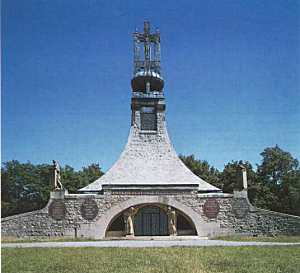Slavkov u Brna - Austerlitz
Slavkov u Brna - Austerlitz |
[Prologue] [Three armies,
two strategies] [Description of the armies] [Before the Battle]
[The Battle] [After the Battle]
 The French occupation of Moravia
ended in the second half of January, 1806. The country could again breathe freely. On
January 12, 1806, the French cleared out from Brno and, over the course of several days,
abandoned the territory of Moravia. Only those incapable of being transported and
deserters stayed behind. Many of them settled permanently in Moravia and established new
families in this foreign land. There are families in the villages around Austerlitz, whose
French names, which have often been heavily modified by Czech, are reminders of their
French predecessors. Surnames like Galle, Mercinery, Audi, Hodi, Trumpes, Tme or
Tmej, Sale and others are examples of this.
The French occupation of Moravia
ended in the second half of January, 1806. The country could again breathe freely. On
January 12, 1806, the French cleared out from Brno and, over the course of several days,
abandoned the territory of Moravia. Only those incapable of being transported and
deserters stayed behind. Many of them settled permanently in Moravia and established new
families in this foreign land. There are families in the villages around Austerlitz, whose
French names, which have often been heavily modified by Czech, are reminders of their
French predecessors. Surnames like Galle, Mercinery, Audi, Hodi, Trumpes, Tme or
Tmej, Sale and others are examples of this.
The tombs on the battlefield of Austerlitz were soon covered by grass. After some time, plows began to turn over the earth again and new crops grew above the bones of the dead. The villages which had been burned down, rose up again from their ashes and again the white church towers dotted the landscape. Heavy farming wagons could again be seen on the Imperial Road to Brno, as could the black and yellow postal stage coaches. Was it, however, the same country as it had been before the battle? Like a tree after a windy storm, like a human body after recovering from a prolonged, serious illness, so the landscape between Brno and Austerlitz had been marked. In this region, where folklore had almost been extinguished, the Battle of Austerlitz gave rise to new traditions, to new folklore. It embued popular legend and custom, as well as the life of the people around Prace Hill, with new traditions.
Even today, stories and legends related to the battle circulate here, as does the legend of the Russian treasure buried by a regiment of the Preobrazhenskij Guard during their retreat. Today, there are still many treasure-hunters digging up various parts of the battlefield in search of the gold and silver left behind by the Russians.
In the popular imagination, the character of the French emperor is especially revered. Although Napoleon only spent part of one month in Moravia in 1805, according to legend from around Brno, he must have felt at home here. The number of villages he is said to have visited and houses and beds he is reported to have slept in, is amazing. He appeared suddenly and equally unexpected was his departure. Napoleon would have had to have stayed at least two more weeks in Moravia for him to have slept in all the houses and beds where he is reputed to have stayed. How can these contradictions be explained when reports in local chronicles document these visits. And still, which of the local people knew the real appearence of the French emperor? Which of them could be sure that they had seen Bonaparte and not one of his marshals or generals, who also wore coats with golden collars and hats with white plumes? These are possible explanations.
However, the traditions of the Battle of Austerlitz have other forms as well. The highest point on Prace Ridge was chosen for a chapel of unusual design, slightly reminiscent of a pyramid. Its steeple is topped with a two - armed cross and reaches a height of 26 meters above the ground. This is the Tumulus of Peace, built at the initiative of the Brno priest, Professor Alois Slovak at the beginning of this century with money raised through public collections. This structure, designed by the architect Josef Fanta, was completed in 1911. Even at that time, the tumulus had been conceived of as an anti-war symbol. The tomb in the tumulus became the final resting place for the bones of the fallen from the Battle of Austerlitz. Even today, bones from the victims of the battle continue to be found in the area. The steps of thousands of tourists have led to this Napoleonic battlefield and to the aweful majesty of death in the middle of this graceful landscape. The tumulus is more than a monument. It is a memorial to the atrocity of war, a warning finger erected above the countryside.
The battlefield at Austerlitz continues to attract visitors from both home and abroad. Every year, on the anniversary of the battle, there are processions to the battlefield, which are associated with the laying of wreaths at the tumulus. People in period uniforms always line the way to the tumulus. Again and again, on the field around Santon Hill, military history enthusiasts reenact the battle in minature, watched by thousands of spectators. On the eve of the anniversary, fires are lit on Zuran Hill. These are a tribute to the fallen soldiers and another living tradition.